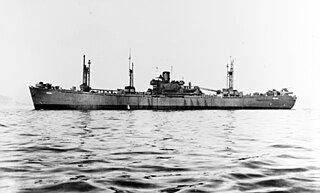
USS Naos (AK-105) was a Crater-class cargo ship commissioned by the US Navy for service in World War II. Naos was named after the star Naos, in the constellation Puppis. She was responsible for delivering troops, goods and equipment to locations in the Asiatic-Pacific Theater.
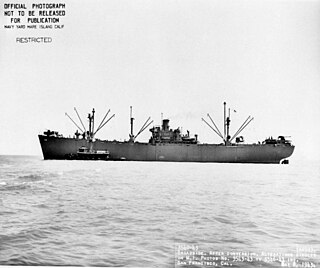
USS Eridanus (AK-92) was a Crater-class cargo ship commissioned by the US Navy for service in World War II and manned by a US Coast Guard crew. She was named after the constellation Eridanus. She was responsible for delivering goods and equipment to locations in the war zone.

USS Triangulum (AK-102) was a Crater-class cargo ship commissioned by the US Navy for service in World War II. Triangulum was named after the constellation Triangulum. She was responsible for delivering troops, goods and equipment to locations in the Asiatic-Pacific Theater.

USS Allioth (AK-109/IX-204/AVS-4) was a Crater-class cargo ship commissioned by the US Navy for service in World War II, named after Alioth, a star in constellation Ursa Major. She was responsible for delivering troops, goods and equipment to locations in the war zone.

USS Matar (AK-119) was a Crater-class cargo ship, converted from a Liberty Ship, commissioned by the US Navy for service in World War II. She was first named after Napoleon B. Broward, an American river pilot, captain, and politician; he was elected as the 19th Governor of the US state of Florida. She was renamed and commissioned after Matar, a binary star in the constellation of Pegasus. She was responsible for delivering troops, goods and equipment to locations in the war zone.
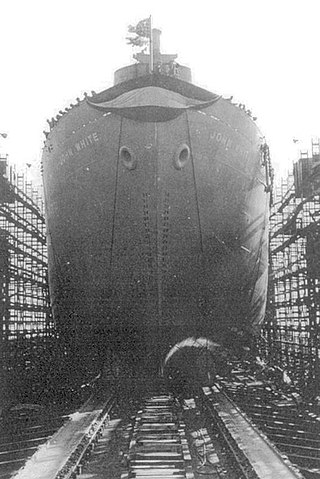
USS Menkar (AK-123) was a Crater-class cargo ship, converted from a Liberty Ship, commissioned by the U.S. Navy for service in World War II. She was first named after John White, a settler among those who sailed with Richard Grenville, to present-day North Carolina, in 1585, to found the Roanoke Colony. White acted as artist and mapmaker to the expedition. He became the governor, in 1587, of the colony, and his granddaughter, Virginia Dare, was the first English child born in the Americas. She was renamed and commissioned after Menkar, the second-brightest star in the constellation of Cetus. She was responsible for delivering troops, goods and equipment to locations in the war zone.

USS Lesuth (AK-125) was a Crater-class cargo ship commissioned by the US Navy for service in World War II. Lesuth was named after the star Lesuth in the constellation Scorpius. She was responsible for delivering troops, goods and equipment to locations in the Asiatic-Pacific Theater.

USS Megrez (AK-126) was a Crater-class cargo ship commissioned by the US Navy for service in World War II. Megrez was named after Megrez, a star in the constellation Ursa Major. She was responsible for delivering troops, goods and equipment to locations in the Asiatic-Pacific Theater.
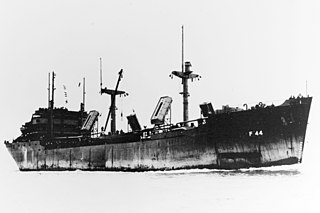
USS Laurentia (AF-44) was an Adria-class stores ship in service with the United States Navy from 1945 to 1946 and from 1950 to 1970. She was scrapped in 1973.
USS Somerset (AK-212) was an Alamosa-class cargo ship that was constructed for the US Navy during the closing period of World War II. She was later acquired by the US Army in 1946 and the US Air Force in 1957 before being reacquired by the USN as the USNS Coastal Sentry (T-AGM-15), a missile range instrumentation ship.
USS Fentress (AK-180/T-AK-180) was an Alamosa-class cargo ship acquired by the US Navy during the final months of World War II. In 1950, she was reactivated and placed into service with the Military Sea Transportation Service as USNS Fentress. She was ultimately transferred to the Trust Territory of the Pacific Islands and the Republic of the Marshall Islands.
USS Herkimer (AK-188) was an Alamosa-class cargo ship that served the US Navy during the final months of World War II. Post-war she served in the Pacific Ocean theatre of operations for some time with the US Army as USAT Herkimer, and then as USNS Herkimer (T-AK-188), with the Military Sea Transportation Service (MSTS) from 1950 to 1973. She was then transferred to the navy of the Trust Territory of the Pacific Islands (TTPI).

USS Pembina (AK-200) – later known as USNS Pembina (T-AK-200) -- was an Alamosa-class cargo ship that was constructed for the U.S. Navy during the closing period of World War II. She supported the end-of-war Navy effort and was subsequently placed in service with the US Army under the Shipping Control Authority for the Japanese Merchant Marine with a Japanese crew in Yokosuka, Japan.
USS Pipestone (AK-203) was an Alamosa-class cargo ship that was constructed for the US Navy during the closing period of World War II. By the time she was scheduled for commissioning, the war’s end caused her to be declared “excess to needs” and she was returned to the US Government and struck by the Navy.

USNS Sgt. Andrew Miller (T-AK-242) was built as Victory ship SS Radcliffe Victory, a Boulder Victory-class cargo ship, built at the end of World War II. She served during the war and its demilitarization as a commercial cargo vessel operated by American West African Lines under charter with the Maritime Commission and War Shipping Administration. From 1946 to 1950, she served the US Army as a transport named USAT Sgt. Andrew Miller. In 1950, she was acquired by the US Navy and assigned to the Military Sea Transportation Service (MSTS). In 1981 she ended her career and was placed into reserve.

USNS Sgt. Archer T. Gammon (T-AK-243) was a Boulder Victory-class cargo ship built at the end of World War II and served the war and its demilitarization as a commercial cargo vessel. From 1946 to 1950 she served the U.S. Army as a transport named USAT Sgt. Archer T. Gammon. In 1950 she was acquired by the United States Navy and assigned to the Military Sea Transportation Service. In 1973 she ended her career and was struck and scrapped.
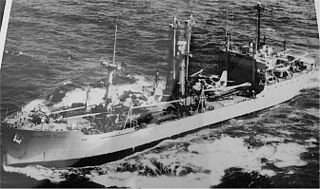
USNS Colonel William J. O’Brien (T-AK-246) was a US Maritime Administration (MARCOM) C1-M-AV1 type coastal cargo ship, originally planned as an Alamosa-class cargo ship. Constructed as Maiden's Eye for the MARCOM, completed in August 1945 and placed in operation by the War Shipping Administration (WSA). After the war Maiden's Eye was transferred to the US Army and renamed USAT Colonel William J. O’Brien who kept her in service until transferred to the US Navy in 1950 for operation as USNS Colonel William J. O’Brien (T-AK-246) by the Military Sea Transportation Service (MSTS) until 1973.
USNS Private John F. Thorson (T-AK-247) was a US Maritime Administration (MARCOM) C1-M-AV1 type coastal cargo ship, originally planned as an Alamosa-class cargo ship. Constructed as Becket Bend for MARCOM, completed in August 1945 and placed in operation by the War Shipping Administration. However, the war ended, and she was transferred to the US Army as USAT Private John F. Thorson who kept her in service until transferred to the US Navy in 1950. She was struck in 1960, ending her military career.
USNS Short Splice (T-AK-249) was a US Maritime Administration (MARCOM) C1-M-AV1type coastal cargo ship, originally planned as an Alamosa-class cargo ship. Constructed as Short Splice for MARCOM, completed in August 1945 and placed in operation by the War Shipping Administration during the closing period of World War II. However, the war ended, and she was transferred to the US Army as USAT Short Splice who kept her in service until transferred to the US Navy in 1950.

USNS Private Frank J. Petrarca (T-AK-250) was a US Maritime Administration (MARCOM) C1-M-AV1 type coastal cargo ship, originally planned as an Alamosa-class cargo ship. Constructed as Long Splice for MARCOM, completed in September 1945 and placed in operation by the War Shipping Administration (WSA) during the closing period of World War II. However, the war ended, and she was transferred to the US Army as USAT Private Frank J. Petrarca who kept her in service until transferred to the US Navy in 1950.













